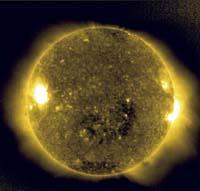The sun advances towards a long calm

A study at the United States National Center for Atmospheric Research (NCAR) reveals that the Sun may move towards a long period of low activity, the last XVII. Towards a calm like that observed in the nineteenth century.
To reach this conclusion, they have looked at the Earth's Van Allen radiation belt. In fact, the Van Allen belt is located outside the Earth's magnetic field, which is the one that receives most of the particles and energies from the Sun. When the activity of the Sun is at the highest level, that is, in times when sunspots are more abundant, many particles touch the earth's radiation belt. Therefore, when the Sun has little activity, it is to be expected that there will be less influence on the belt of Van Allen.
It is currently in the lowest activity of the last 75 years in relation to sunspots, although Van Allen is receiving three times more radiation than in other periods of low activity. The researchers have found that it is not the sunspots that emit radiation, but the plasma jets that periodically leave the Sun. In 2008 the amount of plasma that reached Earth was especially high.
Therefore, it is concluded that the lower the degree of activity, the more jets the Sun emits. It is explained that, when it is at a maximum level of activity, the magnetic field of the Sun is strong and resists the plasma jets. When the activity decreases, the magnetic field weakens, facilitating the exit of the jets. The high plasma arrival in 2008 indicates, according to the researchers, that the Sun is at a particularly low time of activity.
Buletina
Bidali zure helbide elektronikoa eta jaso asteroko buletina zure sarrera-ontzian










